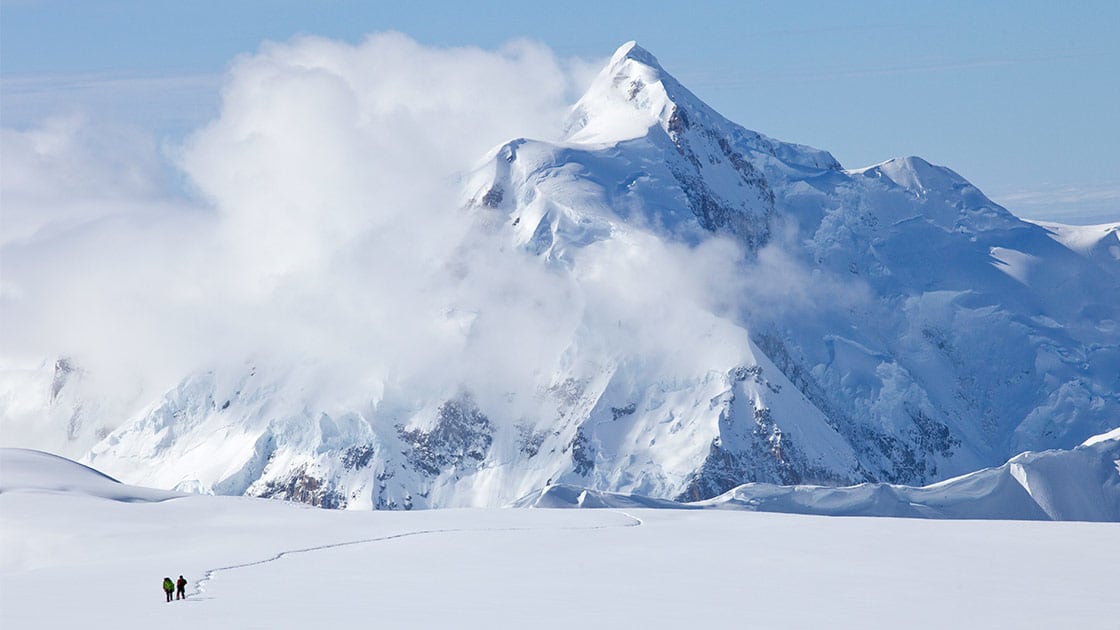Mount Everest isn’t just the tallest mountain in the world, it’s also one of the deadliest. This year alone it has claimed four lives and left several others brutally injured, even missing fingers and toes. And while Everest is known to be a yearly, deadly disaster, in part due to long lines near the summit, its counterpart in North America is vying for competition.
The problem is not the number of people flocking to Denali National Park in U-Hauls—although this is happening due to surging rental car prices—or the cruisers who have reconfigured their Alaskan getaways. Instead, climbers and mountaineers are engaging in riskier than normal behavior on the park’s namesake peak, creating one of the deadliest climbing seasons in years.
On May 3, a skier from Colorado on a multi-day trip fell into a glacier crevasse around Alaska’s Mount Denali and died. On May 13, a climber from Idaho was killed on the mountain by a falling block of glacier ice. His climbing partner was able to call for help, and despite significant injuries, was helicoptered off the mountain. A week or so later, a Canadian climber was seriously injured in what was almost a 1,000-foot fall, but was saved by a nearby helicopter doing routine glacier surveys.
These two deaths make 2021 one of the deadliest seasons on the mountain in recent memory, which from data gathered from 1903 to 2016 is a rate of about three deaths for every 1,000 summit attempts. After 2018 and 2019, when no deaths were reported, and 2020—when the mountain was largely closed off due to COVID-19—these two incidents mark the first confirmed deaths on Denali since 2017. And the climbing season isn’t over yet.
In addition to the deaths, Sharon Stiteler, the Public Affairs Officer for Denali National Park, told The Daily Beast that this season the park has already had to conduct 11 major search and rescue operations on the mountain, which is about on track for the yearly total at the end of each season.
“But again, the real standout has been the mortalities,” Stiteler said.
It’s not entirely clear why more mortalities are occurring. Of course, climbing Denali is an inherently risky endeavor. About 1,200 people a year attempt to reach the mountain’s summit, and only about 60 percent of them succeed. The climb itself is a gruelling trek, one which involves carrying enormous weight, and lugging sleds through snow at high elevations for about three weeks.
Stiteler wondered whether the aftermath of COVID-19 could be to blame. She said that “after a year where we can’t do much of anything, it’s clear that people are anxious to get out and check off all of their bucket list items.”
“This,” she believes, “has led to an increase in risky behavior and poor decision making among climbers.”
In a recent statement, the park laid out some of the risky behavior they’ve noticed recently. Not only are people abandoning their parties and joining others, but according to the park there are misconceptions about the infrastructure, too, and reminded visitors that, “Even though the West Buttress is the most popular and well-traveled route on Denali, [they] are still mountaineering in a remote, high-altitude environment in the wilderness.”
However, perhaps more troubling than infrastructure misconceptions and party abandonment is the trend of climbers attempting to summit the mountain from the 14,000-foot camp, rather than the recommended 17,000-foot camp.
While the difference of 3,000 feet might not seem like a big deal, Jason Martin, the Executive Director of the American Alpine Institute, which leads about nine trips up Denali a year, says it makes a world of difference.
“Going from 14 to the summit is a long day,” Martin told The Daily Beast. “You really have to be in peak physical condition to do such a grueling day, and even then, the margin of error is just, well, really small.”
However, some independent climbers believe skipping the 17,000 foot camp gives them ample benefits. The thought process is, you can leave your gear at 14,000 and climb with less weight. It also allows for the opportunity to take advantage of good weather windows, offering what some believe is a better chance of reaching the summit. But, perhaps the biggest benefit of going from 14,000 feet is this: it means getting to skip camping at 17,000 feet, which is known to be brutal.
“Yeah, 17 does suck,” Martin, who is against this sort of behavior, admitted. “It’s windy and exposed and so people think they can skip it. But the thing is, suffering, well, that’s part of mountaineering.”
Martin said that his tours, and all guided tours on Denali, always follow the Park Service recommendation to go from 17,000 feet to the summit, for a variety of reasons. Not only does the likelihood of altitude sickness go down as you can better acclimatize to the higher elevation if you spend more time up there, but camping closer to the summit and bringing your gear allows you to be prepared if you need to wait out the weather.
“In short, it’s much, much safer,” Martin said.
Despite this, some people seem to think the Park Service’s advice is causing a larger problem.
Tyler Kondelik, a 35-year-old from Newman Lake Washington, reached the summit of Denali in 2018 from 14,000 feet, with his team of three. He told The Daily Beast that the biggest challenge wasn’t the climb, but the crowds of people near the top.
“There were queues of people at 17,000 that forced us to wait for hours,” he said. Despite this, Kondelik wondered whether some people in guided groups should even be on the mountain in the first place.
“Basically these guided groups are filled with people who don’t have mountaineering experience and are paying people big bucks to carry them up the mountain,” he said, adding, “The queues are definitely ruining [Denali] in a lot of ways, making it more dangerous, and unfortunately, I’d say it’s because of these guided groups.”
“This is not true,” Martin said. In fact, he contended that one of the main differences between Everest and Denali is that unlike Everest, where he said, “You have a lot of guide services run by low-end operators, that will pretty much take anybody, even people with zero experience,” on Denali, “All companies require extensive mountaineering experience.”
“We thoroughly vet and interview each and every one of our clients and ensure they are ready for it. If they’re not, we suggest they do a different trip first,” he said. “A lot of the climbers we take have the technical skills to climb the mountain, but maybe not the planning capabilities to organize the entire expedition themselves.”
But ultimately, while you might hope that atop a 26,000-foot mountain, there would be peace, quiet and serenity, on Everest there are frequently tons of traffic jams, even what appears to be a conga line at times—often with deadly results. It’s made worse by the fact that “everyone on Everest is waiting for that one day to summit,” Martin said.
“That’s the thing about Denali,” Martin said. “I think all-in-all it’s a harder mountain to climb than Everest. But with Denali, there are way more summit opportunities, and people just get really caught up, thinking the summit is the final goal.”
“But the main thing is, we’re not doing stupid shit up there. Our goal is to ensure everyone’s safety,” he said. “Summiting is optional. But coming down? That’s required.”

